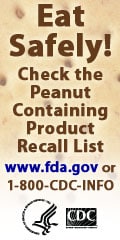The truth about methicillin-resistant Staphylococcus aureus (MRSA) may surprise you. MRSA is a type of bacteria that causes skin and other kinds of infections. Sometimes called “the superbug,” MRSA is resistant to certain antibiotics, but several antibiotics still work. And many times, antibiotics aren’t even needed -- doctors are often able to treat MRSA skin infections by simply draining them.
Because skin infections caused by MRSA are increasing, the Centers for Disease Control and Prevention (CDC) launched a new campaign to educate families about MRSA. Although most of these skin infections are mild, some infections may become life-threatening. There are a few simple steps you can take to protect yourself and your family from MRSA skin infections.
Step 1: Know the signs and symptoms of MRSA and get treatment early
A staph skin infection, including one caused by MRSA, usually appears as a bump or infected area on the skin that may be red, swollen, painful, warm to the touch or full of pus or other drainage. It is especially important to contact your health care provider if these signs and symptoms are accompanied by a fever.
Step 2: Keep cuts and scrapes clean and covered
Keeping cuts and scrapes covered will help prevent spreading bacteria to others. If you think the area is infected, contact your healthcare provider and follow their instructions about proper care of the infection. Be sure to discard used bandages in the trash.
Step3: Encourage good hygiene such as cleaning hands regularly
Bacteria and other germs are often spread from person to person by direct contact – mostly by our hands. Clean your hands frequently with soap and water or an alcohol-based hand rub, especially after changing a bandage or touching infected skin.
Step 4: Discourage sharing of personal items such as towels and razors
Avoid sharing personal items such as towels, washcloths, razors, or clothing that may have had contact with infected skin or soiled bandages. Wash sheets, towels, and clothes with water and laundry detergent. Water temperatures for household laundry depend on the type of fiber or fabric of the clothing. In general, wash and dry in the warmest temperatures recommended on the clothing label. Use a clothes dryer to dry clothes completely.
For more information on the CDC’s campaign, please visit www.cdc.gov/MRSA.
-------
This article has been reproduced with the kind permission of the Centers for Disease Control and Prevention.
skip to main |
skip to sidebar
This is the blog of the Amherst Public Health Department. Here you'll find public health updates, links to health-related sites, blog posts by employees of the Amherst Public Health Department, and various articles of interest. Feel free to contact us by email via a link in our profile. Please bookmark this page and visit often!
About Us
- Amherst Health Department
- Amherst, MA, United States
- The mission of the Amherst Board of Health, working through the Health Department, is to promote the health and well-being of our community with special emphasis on eliminating health disparities. We fulfill this mission through our core functions: assessment, assurance, promotion, and policy development.
Twitter Updates
Blog Archive
-
▼
2009
(102)
-
▼
March
(18)
- Nationwide Recall of Nantucket Blend Trail Mix
- FDA Alerts Consumers to Pistachio Recall
- Statement on GI Illnesses at Babson College
- Including Public Health in National Health Care Re...
- CDC Recommends Shingles Vaccine
- Amherst Health Department Rabies Clinic
- FDA Uncovers Additional Tainted Weight Loss Products
- Collecting Your Family's Medical History Could Sav...
- Flu Activity Continuing to Decline
- Play It Safe When It Comes To Concussions
- Know the Truth about MRSA Skin Infections
- The Amherst Public Health Department: Using Scienc...
- FDA Issues Guidance for Food Manufacturers on Use ...
- Influenza Activity Declining in Massachusetts
- Whole Foods Recalls Pancake and Waffle Mix
- Prostate Cancer and African Americans
- Campaign Helps Hispanics With Diabetes Enjoy Healt...
- Antiviral Resistance and Flu Vaccine
-
▼
March
(18)
Labels
african american health
(1)
alcohol
(1)
animals
(1)
asbestos
(1)
asthma
(1)
cancer
(2)
CDC
(14)
children
(5)
diabetes
(1)
elder safety
(1)
events
(2)
family
(1)
FDA
(6)
fitness
(3)
food insecurity
(2)
food safety
(1)
H1N1 Influenza
(24)
health care
(1)
health disparities
(2)
Hispanic health
(1)
infectious disease
(5)
influenza
(9)
Latino health
(1)
medication disposal
(1)
MRSA
(2)
obesity
(1)
pandemic flu
(1)
pregnancy
(1)
public health
(5)
rabies
(1)
recalls
(27)
safety
(2)
salmonella
(11)
screening
(1)
STDs
(1)
technology
(1)
teenagers
(3)
Tick-borne illnesses
(1)
vaccinations
(2)
West Nile Virus
(1)
winter safety
(2)
young adults
(2)
Other Official Amherst Blogs
Amherst Resources
Local Health Resources
Other Local Health Dept Blogs
Health & Fitness Links
- America on the Move
- American Cancer Society
- American Diabetes Association
- American Medical Association
- BlackDoctor
- Fitness.gov
- Health.gov
- HealthFinder.gov
- HealthierUS.gov
- Healthline.com
- Healthy People 2010
- KidsHealth.org
- Mass In Motion
- MedlinePlus
- Nat'l Center for Complementary & Alternative Medicine
- National Health Information Center
- New York Times Wellness Blog
- SparkPeople
- WebMD
- Wellness.com
- Wellsphere.com
- WomensHealth.gov
Public Health Links
- American Public Health Association
- CDC Travelers' Health Website
- Centers for Disease Control
- Food and Drug Administration
- Food and Drug Administration
- GlobalHealth.gov
- MA Dept of Public Health
- MA DPH Public Health Blog
- Nat'l Assoc. of City & County Health Officials
- Nat'l Center for Farmworker Health
- National Institute for Mental Health
- National Institutes of Health
- Office of the Surgeon General
- Pioneer Valley Red Cross
- U.S. Department of Health & Human Services
- U.S. Food & Drug Administration
- Unnatural Causes
- World Health Organization





